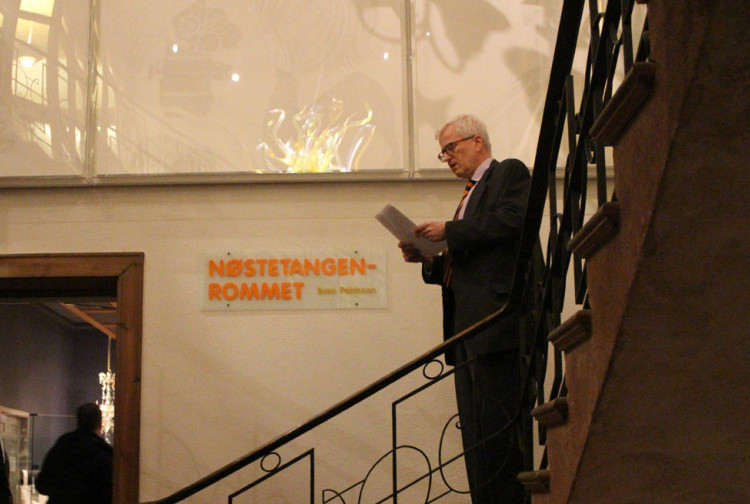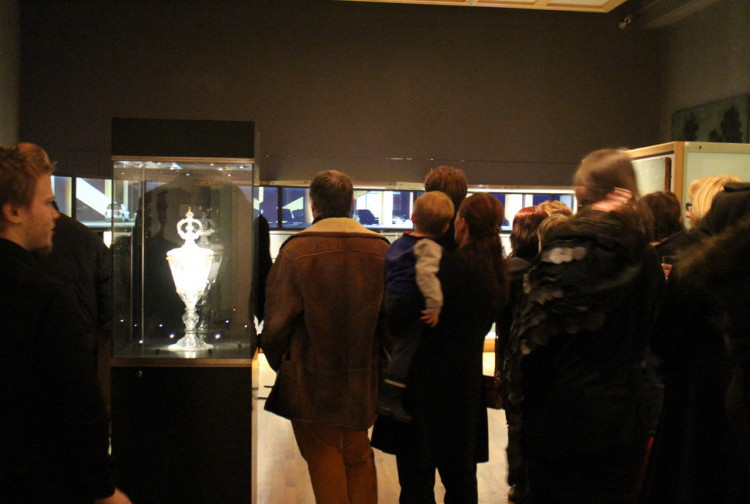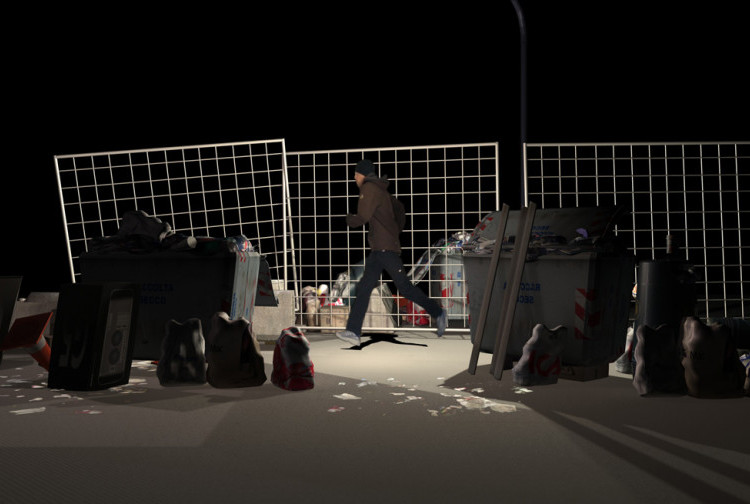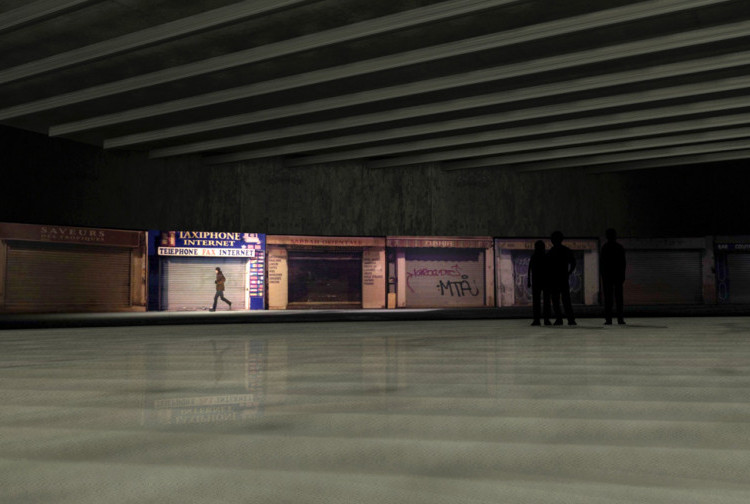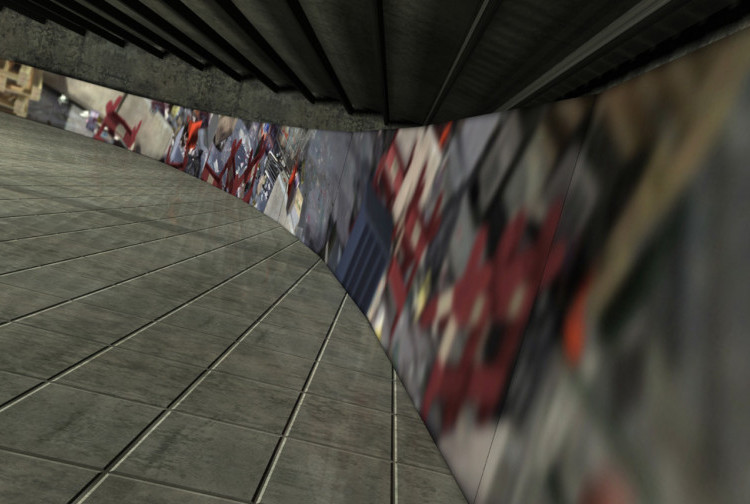Sven Påhlsson in the Nøstetangen room
Sven Påhlsson shows for the first time his new work Running High in the Nøstetangen room at Drammens Museum. This work is shown here on twelve flat screens where the film's extremely panoramic widescreen format is seen as a coherent frieze.
Påhlsson's work is made possible with a groundbreaking visual technology, which makes it possible to break away from the traditional film and video format's rectangular picture frame, and create a virtual picture space with an infinity of points of view. This is seen in the film in that one of the main characters - a young, anonymous man who runs - moves continuously in front of a reconstructed barren urban landscape. As in all of Påhlsson's work, there is considerable research work behind it, not only in computer technology, but also sociology and modern urban planning. For this is what characterizes his art, that research is necessary for him to be able to create visual film images that affect the tiksuar mentally and invite reflection on the important questions he wants to put under debate. The technique serves the idea, not the other way around. In this case, there is also an interesting reflection between technique and theme, because this work can be shown in different editions and different sizes.
The image sequence is typical of today's image streams that can be put together and synthesized and constantly re-mediated.
The theme of Running High is, as in early works, how people's built environment affects their lives, and is a result of political processes and changes in the economic and social realities that characterize today's big cities. The backdrop is the colossal apartment block districts on the outskirts of European cities such as Paris and London, places that became a catalyst for the riots in Clichy Sous Bois, Paris 2005 and Tottenham, London 2011. Here are those who are at the bottom of the social ladder and where the financial crisis's welfare tightening has hit hardest. In addition, the ethnic composition is far more complex than in other parts of society and the level of conflict is constantly high.
We know from the news broadcasts the social problems and feelings of hopelessness that characterize the lives of many of those who live in such suburbs. The young man who runs in an eternal evening light, runs and runs, but without a clear goal, and it is unclear whether he is running towards something or from something. He runs continuously, but is he really moving forward to any particular degree? In some sequences he runs at high speed forwards but still ends up further backwards, in some sequences he passes places that still have to be passed over and over again. It is as in the past, a charged and gloomy atmosphere works in the work. The public can ask themselves whether this is how it feels for those who have been "left over" in the welfare society and are placed in places that become a terminus and do not go anywhere.
Character tips
Sven Påhlsson shows for the first time his new work Running High in the Nøstetangen room at Drammens Museum. This work is shown here on twelve flat screens where the film's widescreen format is seen in a continuous frieze. Påhlsson's work is made possible with a groundbreaking technology, which both makes it possible to create digital images with very high resolution and create a virtual image space with an infinity of points of view. This is seen in the film in that one of the main characters - a young, anonymous man who runs - moves in front of a reconstructed barren urban landscape and in that a virtual camera can show a myriad of detailed micro-scenes that support our insight into the reality the artist examines. As in all of Påhlsson's work, there is considerable research work behind it, not only in computer technology, but also sociology and modern urban planning. For this is what characterizes his art, that research is necessary for him to be able to create visual film images that affect the viewer mentally and invite reflection on the important questions he wants to put under debate. The technique serves the idea, not the other way around. In this case, there is also an interesting reflection between technique and theme, because this work can be displayed in different presentation forms and different sizes. The image sequence is typical of today's image streams that can be put together and synthesized and constantly re-mediated. In his new book, After Art (2013), art historian David Joselit reflects on the power of images after the time of object-based artwork is over. Contemporary paintings do not leave authentic imprints. In such a time, there is more talk of images than art objects. Images are no longer unambiguously linked to the visual and immutable design of an object, as we are used to being in painting, drawing and sculpture. The images in the new situation have the property that they are made in a volatile, modelable medium, without any unambiguous, material existence. They are not physically unique that radiate aura and must be sought out and experienced in authentic encounters in unique places. Images in the time "after art" can exist in electronic fields where image information flows, and they can be constantly re-mediated. The constant in a work like Running High is a giant collection of coded information and this is produced by the artist. And this is the very phenomenology of a video work like this. Not only can they appear in different physical and institutional settings, with their symbolic values and significance, they can also resize and spread over very large areas through projection. Which in turn will change the audience's experience of them. And you can take an infinite number of still images and sections that can be re-mediated in the form of digital photos or prints. The artist has full control of the scenography and screenplay, but the virtual world that has been created potentially contains other directions of movement and paths.
Running High is a video film where the image stream is displayed in very high resolution, and as I said, large amounts of information must be processed so that we can see the long frieze where a lone runner jogs along the ground in "the barren land". What is of greatest interest to the audience is that the technology that makes it possible to construct images and compose the events in the film is the late-capitalist logic that produces, controls and maintains capital flow and that increasingly produces image products for mass consumption. The technology that enables the globalization of production, marketing and consumption of goods is the technology that has perhaps its ultimate utility in producing and disseminating images for consumption, in news dissemination and entertainment, but also for aesthetic consumption. According to Fredric Jameson, what characterizes the cultural logic of late capitalism is that the diachronic is displaced in favor of the synchronous. This emerges in contemporary culture in that simultaneous enjoyment of images is prioritized in relation to accountable and reflective storytelling. And if we connect technology and medium to the understanding of time, this becomes really interesting. For the point of synchrony, that things are experienced as simultaneous through image consumption, is that time difference as a historical course tends to disappear from attention. Typical in this way are the costume dramas in recent films, where English and American literature from the 19th century is filmed with living actors (necessarily) and enjoyed as entertainment without having to think about what separates that time from ours and what material structures created the social contexts, joys and sorrows, which we can experience carefree in beautiful lighting, with magnificent colors, in beautiful surroundings and with evocative soundtracks. A diachronic approach to time, like history, entails an irreversible understanding of time. Something comes before something else, what happens later is a result of something that has happened before. The left in politics has been particularly concerned with maintaining this perspective, since in their perception of reality there is a necessary dynamic that works in history through the maintenance of and changes in production conditions. Without this momentum and its power to change, there is no hope for a better society. The dynamics which, according to this understanding, seem dialectical, to some almost like a legality in matter and time (History), it is especially important to analyze the social phenomena depicted in a film.
In the case of Running High: what comes out of a diachronic reflection on the processes that have preceded life in the apartment block towns, the so-called New Towns in England, and more recently the much talked about "suburbs" in Paris. Increased relocation to the cities, redevelopment of slum areas and the need for new establishments of efficient "housing machines" are some of the reasons for the emergence of the large housing complexes. Imperialism and the north-south conflict are some of the explanations for why there is a composite population in these areas. The change in rules for free movement of goods, money and labor in the European Union, together with the possibility of importing cheap goods from Asia, explains the structural changes in European industry and rising unemployment among groups that have traditionally filled industrial jobs. Immigration and refugee flows can be explained by conflicts rooted in colonial times, etc. All these historical processes create a need for affordable housing, where many apartments can be built on relatively few expensive square meters. Such explanatory models presuppose that history is something that changes, that it is a dynamic progress that makes it possible to keep alive a utopian dream that changes will be able to bring better times for those who are today oppressed and fall short. The functionalist background of the neo-brutalist housing colossi Påhlsson depicts was utopian and had social welfare and good health as its purpose when this emerged in the late 1920s. In the sequence some distance out in films, a kilometer-long row of large lamella blocks of the type Andreas Gursky made memorable is seen through the color photograph Montparnasse, Paris, from 1993.
How does the time phenomenon work in the digital image streaming world? Is the story over, while the time of the lone long-distance runner goes as smoothly and relentlessly as the jogging pace? When Francis Fukyama's book The End of History and the Last Man came out in 1992, there was an outcry, because without a further historical continuity through a dynamic, dialectical process it would be difficult to imagine a freer, fairer - in short BETTER - new world . In the digital image stream, images have quite a tremendous power, something David Joselit also points out. But in the electric current there is a movement, a flow, but technically there is nothing to indicate that it is a directional, irreversible time. Mediation of images enables re-mediation of images. Images that once appeared for a time can be put into and mixed in the mediated image stream regardless of their starting point. The runner in Running High could just as easily be moved to a pastoral landscape in the English or French countryside or a beach on the Mediterranean. With such transfers, the meaning of images changes. The only way to maintain a diachronic understanding in the midst of meeting the synchronous image flow is to find out where images come from and track their circulation after they have entered the distribution networks, whether they are commercial TV channels, on websites or in films shown in art museums. It goes without saying that this is an almost hopelessly large task, which gets worse and worse every time an image is clicked, downloaded, re-photographed or scanned and put into the image flow. David Joselit is painfully aware of this, but that is what he prescribes in his new book: «» The after in my title, unlike Danto's use of the prefix post in his preferred term posthistorical, is meant to indicate both the reverberations of images as they spread (as in the term afterimage) as well as the patterns of circulation that emerges after images enter networks. Indeed, I believe we need to write histories of image circulation, of which After Art is a modest contribution ”.
What a time experience Påhlsson's film presents. They are a smooth, uneventful "story", or perhaps more an opportunity for a story. If there is to be a story, the agent is a lone long-distance runner who we see jogging along a stage carpet constructed of famous images from the apartment block ghettos in European metropolises. There is no beginning, no middle ground, no end to the run. In the virtual world, calories are not burned, the heart does not have to beat and wear out, joints and muscles are not strained, so thinking about fatigue is completely meaningless. The film's phenomenology gives no physical response to the viewer. The "runner" jogs in a loop, the energy has nothing to do with the human body, the energy is electrically supplied and electrically maintained. The figure starts to run when the power is turned on, it stops running when the switch is turned off. The experience of the film thus presupposes that the spectator is alienated from the events in the film.
The scenography has a certain diachronic index, we can see that the buildings are getting old and there are no signs of life in the apartments. All lights are off, only rubbish bins, parked cars and piles of rubbish and road or construction site barriers are the props in the scene. It must be late at night, as everything is quiet, well before dawn, which comes towards the end of the film. The areas appear as a permanent staging post. But little indicates rehabilitation, little indicates change, little indicates that history still works. This applies to the buildings that have reached a kind of normal state of suitable wear, but not decay. There is little indication that the story works in the figure that runs. His time is the time of the clock and the time of the flow of electricity. Time goes by, but there is a lack of human agents breaking in. Great-grandfather, grandfather, father, uncle, brother have been and are without work. Is it possible to get a job? Or will life now and in the next generation become a lasting existence in this place, in the apartment, on social security? This sounds passive and negative, but it is not the first time art can be said to indicate such pessimism. Both Courbet's, Daumier's and Millet's realistic depictions of the life of the underclass in France around 1850 can be interpreted as meaning that poverty is something that goes on for generations. In England, there has been talk for many years about children growing up without parents and the grandparent generation having been in paid work. Children grow up without any relationship to "work", none of their loved ones go on or ever come home from work.
Does the film show signs of change in the logical continuity and sustained downtime just described? Garbage containers and residual materials are evidence of an activity, a consumption. The rubbish will be collected. New residents have arrived, in large, expensive cars. The signs on the row of SUVs indicate that new residents are in place, but with a different starting point than those who have traditionally lived in the social housing. The car and the country of origin also give a hint that there is a dynamic and an economic vector inside the picture that may well cause them to leave the apartment blocks as quickly as they came, just to emphasize the persistent stagnation of those who were there and will stay there. But otherwise it is the persistent, digitally perpetual jogging and makeshift, persistent fallow land areas, which signifies that history as we have been accustomed to understanding it is over. The electricity supply will remain as long as the transformer and cable kiosks and the well-maintained, extensive power supply facility are not exposed to vandalism or sabotage. The parked planes and helicopters, on the other hand, have landed and there is no indication that they will take off. They represent an economy that does not work in the city ghetto. The runner is a character, denoting a typical western resident young, white man, with tracksuit with hood and sneakers. A uniform that covers most things, from young people who train and young people who hang around, and young people who engage in drugs and crime. The uniform covers a lot, but says little, except that it anonymizes the person wearing it. So is the runner someone who has strayed from the villa suburbs, the elegant city center, or does he belong here? The calm jogging suggests that he belongs here. The film gives no indication of where he comes from or where he intends to go. On the contrary, the indication is that he is not going anywhere, since he may have nowhere to go. He is thus imprisoned for lack of opportunity.
The film's title - Running High - is an expression that is associated with mood waves, to strong affects that are experienced when faced with something exciting or horrible. It is somewhat similar to the term "Runner's High", which applies to runners, ie runners who run so long that endorphins are secreted in the body, which gives a feeling of lightness and elation, almost like an intoxication. It is this well-known phenomenon that makes it meaningful to talk about a "fitness junkie"; yes training can make you dependent on the pleasure of running. One possible interpretation is that the runner counteracts the melancholy in solitary, monotonous running, by taking responsibility for one's own health and using the feeling of running desire to intensify the impulse flow of the nerves and the lust-rush of the hormones. The signs give no indication as to whether this should be interpreted as the beginning of gathering forces to start a revolt. Or is it individual self-care, an alternative to the passive effect of large-scale consumption of light-shimmering, electronic image streams? Image power consumption provides a consumption that generates significant profits for producers and licensees, and is a not insignificant effect of and acceleration to the global flow of people, goods (including floating images) and services (including power supply and heating) today fills the last residential ghettos of industrialism .
The relationship between these two expressions, one of which - that is, what is the film's title and which is to a small extent designated in the film, opens up for several possible interpretations. Is "the lack of events", and the steady movement in the film a warning that emotions are about to pile up, as in "quiet before the storm" or "a ticking bomb", both terms used in analyzes of the situation in the depleted, socially and economically parked apartment block areas. In that case, this is denoted by negation, as a romantic painting of a gloomy sky can carry the message that a blizzard can break out. There is a short sequence in the film that indicates that there are external forces at work (symbolic of the "forces of society"?) Where concrete blocks, containers and safety nets inexplicably begin to move and collide and come dangerously close to the runner. Påhlsson has also added a sequence here where we follow a moving "camera gaze" placed up between the trusses in a roof construction, a look that follows what is happening. We get a hint about who or what it is that monitors in the film.
Påhlsson has also added a sequence here where we follow a moving "camera gaze" placed up between the truss in a roof construction, or a giant stand for advertising, a gaze that follows what is happening. We get a hint about who or what it is that monitors in the film. Running High is a visually intense work, in the shift between electric darkness and the strong light towards the end. The experience and interpretation is controlled by following the runner and scanning over the wide urban landscape he jogs in. We try to live in what it feels like to be here, an empathy that draws on what we know about and have experienced in similar, barren surroundings. But an important part of the work is the music, composed by Erik Wøllo for this particular film. We know how important timing and rhythm are when writing film music, even where it - and as a rule - is lavishly evocative. It goes by a tenth of a second and that the editing and visual sequence of events structurally coincides with the music. Here, the music is a soundtrack that is experienced as the sound of the runner's feet when they hit the ground, his breathing, and heartbeat. The music is subtly located as a basic flow along the visual progress, and it affects the experience more than we first realize. Because the soundtrack is connected to the runner, he, as the film's agent and center of interpretation, is also put in a stronger focus for our attention. The music pulls us towards the runner. A feeling of space is created through sound and reverberation and this in turn helps to create the experience of a physical space around the runner. And the fact that there is an echo here means that the surroundings also make sounds. It is as if something is smoldering in an environment that is otherwise presented as passive and neutral, until they begin to move by themselves (possibly as a result of a virtual pressure wave) as when concrete blocks and metal fences collapse behind the runner.
This is, as others by Sven Påhlsson work, a romantic work of art. It is an allegory without progress, it is an allegory (where the props are only stacked together), over a social melancholy, which is made visible by a persistent, gloomy night mood that ends in a flat, strong and uncharacteristic light. The infinity of the gloomy, unspeakable backdrop is a source of the socially sublime. In Romanticism, it was a lone wanderer or a monk by the sea who witnessed the topographically sublime. Here it is the runner who becomes a stand in for us, who does not, as with Caspar David Friedrich, stand with his back to the spectator, while we follow from the side. Through this silent, anonymous agent, the spectator can live in a situation where one is met by the sublime, in this case, the socio-economically sublime. The spectator stands there distant and existentially alienated, but as a witness. The fact that the runner does not appear with a goal in sight can be seen as a loss of meaning. Is it hope, acceptance or resignation? This is a social situation that has existed in European and American cities for generations. The question is whether there is a way out of social housing, whether nature will make room for a new (social) morning, or as it is called in our days «a… spring»?
All artistic works, whether they are made as stable objects or appear as image streams, consist of what in sign theory is called "significant", or "signifiers", the physical we can see. But it is only half the structure of the sign, for the sign also has a «designation» or «meaning», a «significance». And it is when the physical or visual form of the sign is connected to what it can mean, that a meaning arises in art. And this is a process that depends on interpretation. In dogmatic modernism, people lived under the delusion that the artist who had shaped the signifier was the sole and final guarantor of the interpretation or meaning of the work of art. But that delusion has not survived either the neo-Marxist and structuralist or the postmodern critique that became important as early as the 1950s. It was probably this type of ideology that the postmodern uprising was about. So it is not given in Running Highs form and course has any unambiguous interpretation. Everyone can help to find meaning in it, but it is assumed that the phenomena, motives and events that the film's visual characters point to are respected. There are objective phenomena in the world we have in common. The artist has, of course, conducted his research in the districts of London and Paris that house the social reality he wants to problematize. And the choice of characters and props in the film's scenography gives just such directions, where the film's images point to their possible designations and their origins. So the meaning of the work lies in the fact that the interpretations must be aimed at the suburbs and apartment block districts. But the meaning does not exist complementary there only in the piety of visual signs, which is the limited reality the artist is referred to use. Everyone can make their own interpretations, but we must remember that it is objective historical phenomena and discussions (with their differences of opinion and ideological conflicts) that govern how we try to understand this video work. As they have been guiding the thoughts I have tried to express here.
Åsmund Thorkildsen
Museum director
Venue
Monday to Friday 11.00 - 15.00
Wednesday 11.00 – 18.00
Saturday 11.00 – 16.00 (free admission)
Sunday 11.00 – 16.00

